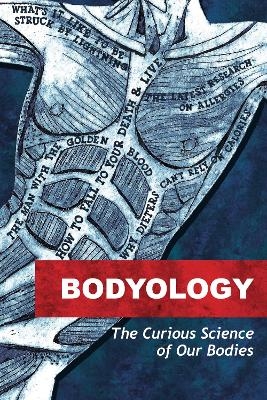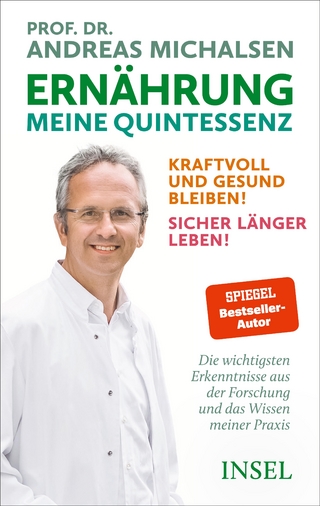
Bodyology
Canbury Press (Verlag)
978-0-9954978-6-3 (ISBN)
Ever wondered what it’s like to be hit by lightning or to lose your sense of smell? Heard about the woman saved by bee stings — or the window cleaner who survived a 400ft fall?
Originally written for the Wellcome charity, 16 stories by leading science writers explore the mysteries of the human body. Learn about everything from diets to allergies, hair colour to rare blood, and from allergies to remote surgery.
Contents
What’s it like to be struck by lightning? - Charlotte Huff
Why do we colour hair? - Rebecca Guenard
The man with the golden blood - Penny Bailey
Why dieters can’t rely on calories - Cynthia Graber
3D printers can now make body parts - Ian Birrell
How to fall from a skyscraper and live to tell the tale - Neil Steinberg
The quest to explain miscarriages - Holly Cave
Can the power of thought outwit ageing? - Jo Marchant
Seeking a ‘cure’ for male baldness - Rhodri Marsden
How bee stings saved a woman’s life - Christie Wilcox
The global trend for ‘kangaroo’ babies - Lena Corner
What it means to lose your sense of smell - Emma Young
The doctor aiming to end eye pain - Bryn Nelson
Could allergies be a defence against noxious chemicals? - Carl Zimmer
Why pharma may be going slow on the male pill - Andy Extance
How virtual reality headsets aid remote surgery - Jo Marchant
Shhh! What exactly is the menopause? - Rose George
Extract
What it's like to be struck by lightning?
Sometimes they’ll keep the clothing, the strips of shirt or trousers that weren’t cut away and discarded by the doctors and nurses. They’ll tell and retell their story at family gatherings and online, sharing pictures and news reports of survivals like their own or far bigger tragedies. The video of a tourist hit on a Brazilian beach or the Texan struck dead while out running. The 65 people killed during four stormy days in Bangladesh.
Only by piecing together the bystander reports, the singed clothing and the burnt skin can survivors start to construct their own picture of the possible trajectory of the electrical current, one that can approach 200 million volts and travel at one-third of the speed of light.
In this way, Jaime Santana’s family have stitched together some of what happened that Saturday afternoon in April 2016, through his injuries, burnt clothing and, most of all, his shredded broad-brimmed straw hat. “It looks like somebody threw a cannonball through it,” says Sydney Vail, a trauma surgeon in Phoenix, Arizona, who helped care for Jaime after he arrived by ambulance, his heart having been shocked several times along the way as paramedics struggled to stabilise its rhythm.
Jaime had been horse-riding with his brother-in-law and two others in the mountains behind his brother-in-law’s home outside Phoenix, a frequent weekend pastime. Dark clouds had formed, heading in their direction, so the group had started back.
They had nearly reached the house when it happened, says Alejandro Torres, Jaime’s brother-in-law. He paces out the area involved, the landscape dotted with small creosote bushes just behind his acre of property. In the distance, the desert mountains rise, rippled chocolate-brown peaks against the horizon.
The riders had witnessed quite a bit of lightning as they neared Alejandro’s house, enough that they had commented on the dramatic zigzags across the sky. But scarcely a drop of rain had fallen as they approached the horse corrals, just several hundred feet from the back of the property.
Alejandro doesn’t think he was knocked out for long. When he regained consciousness, he was lying face down on the ground, sore all over. His horse was gone.
The two other riders appeared shaken but unharmed. Alejandro went looking for Jaime, who he found on the other side of his fallen horse. Alejandro brushed against the horse’s legs as he walked passed. They felt hard, like metal, he says, punctuating his English with some Spanish.
He reached Jaime: “I see smoke coming up – that’s when I got scared.” Flames were coming off of Jaime’s chest.
Buy the book to read on...
Mosaic Science is a project founded by the health charity Wellcome to popularise high-quality science writing. Mosaic has published dozens of stories exploring the science people care about. Canbury Press has curated these stories into two books, Bodyology: The Curious Science of Our Bodies (ISBN 9780995497863) and Brainology: The Curious Science of Our Minds (ISBN 9781912454006).
INTRODUCTION. All of the stories in this book were first published by Mosaic (mosaicscience.com), created by Wellcome, a global charitable foundation dedicated to improving human health. They are republished here under a Creative Commons licence. Some edits have been made, including to the headlines
1. WHAT'S IT LIKE TO BE STRUCK BY LIGHTNING? By piecing together bystander reports, the singed clothing and the burnt skin can survivors start to construct their own picture of the possible trajectory of an electrical current that can approach 200 million volts and travel at a third of the speed of light
2. WHY AND HOW WE COLOUR HAIR. Humans have dyed for thousands of years, experimenting with ever-changing, often vicious, formulas to achieve a new hair colour. Along with ammonia, hair dye formulas contain hydrogen peroxide, a bleaching agent. Peroxide reacts with the melanin, removing natural colour
3. THE MAN WITH THE GOLDEN BLOOD. On the trail of rare blood, who gives it and why? Some blood can be as rare as 1 in 100 million. The majority of the 342 blood group antigens belong to one of 35 blood group systems. Finding a donor and getting rare blood to a patient in crisis can be a desperate race
4. WHY DIETERS CAN'T RELY ON CALORIES. More than two-thirds of American adults are overweight or obese. One in three are attempting to lose weight by dieting. Yet there is ample evidence that diets rarely lead to sustained weight loss. Because a calorie isn’t just a calorie – and that's the problem
5. COULD 3D PRINTERS MAKE BODY PARTS? Stories of lives devastated by conflict or disease are all too common across low-income countries. Lack of an arm or leg can be tough anywhere, but for people in poorer parts of the planet, with so much less support and infrastructure, it is especially challenging
6. HOW TO FALL 400FT AND LIVE TO TELL THE TALE. Alcides Moreno was a window washer in New York City when he fell from the 47-storey Solow Tower. Falls are the second leading cause of death by injury in the US, after car accidents. Yet we are more fearful of terror attacks, shark bites and Ebola outbreaks
7. MISCARRIAGE: THE RACE TO PROTECT PREGNANCIES. The unspecified genetic abnormalities that are said to underlie most miscarriages have various possible causes. The risk of random genetic faults in the fetus seems to increase with the age of the mother. There are several other potential causes
8. CAN MEDITATION OUTWIT AGEING? Whereas Western biomedicine has traditionally shunned the study of personal emotions, a team led by a Nobel Prize-winning biochemist at the University of California, San Francisco, is engaged in serious studies hinting that meditation might slow ageing and lengthen life
9. SEEKING A 'CURE' FOR MALE BALDNESS. Androgenetic alopecia is the medical term for inherited hair loss, and while it affects both men and women, it’s men whose anxieties tend to be targeted by the hair loss industry. It’s estimated to be worth at least $1.5 billion a year worldwide
10. HOW BEE STINGS SAVED A WOMAN'S LIFE. ‘I moved to California to die.’ Ellie Lobel was 27 when she was bitten by a tick and contracted Lyme disease. She had 15 years of pain and disability. And she was not yet 45 when she decided to give up fighting for survival. A swarm of Africanised bees saved her
11. THE GLOBAL TREND FOR 'KANGAROO' BABIES. Kangaroo Mother Care (KMC) is the brainchild of Colombian paediatrician Edgar Rey, who introduced it to the Instituto Materno Infantil in 1978. It was an idea born out of desperation. Death rates and infection levels dropped immediately
12. WHAT IT'S LIKE TO LOSE YOUR SENSE OF SMELL. People who can no longer smell – following an accident or illness – report a strong sense of loss, with impacts on their lives they could never have imagined. Smell is not ranked highly among our senses – until it's gone (as many with Covid have found)
13. THE DOCTOR AIMING TO END SEVERE EYE PAIN. At 82, Boston ophthalmologist Perry Rosenthal has become the nerve centre of a small but growing network of researchers and clinicians seeking out new explanations for the often jarring disconnect between brutal symptoms and a lack of clear signs
14. ALLERGIES — A DEFENCE AGAINST NOXIOUS CHEMICALS? Allergens include latex, gold, pollen, penicillin, insect venom, peanuts, papayas, jellyfish stings, perfume, eggs, house mites, pecans, salmon, beef and nickel. Why? At Yale School of Medicine, Ruslan Medzhitov has a theory
15. WHY BIG PHARMA MAY BE GOING SLOW ON THE MALE PILL. Researchers are as confident as they can be that they’re close to overcoming the scientific barriers. Now, the multimillion-dollar question seems to be: Who is actually going to make the male pill happen?
16. HOW VIRTUAL REALITY IS AIDING REMOTE SURGERY. A 54-year-old surgeon at Panamerican University in Mexico City, he’s on a mission to bring virtual reality into the operating room, using the high-tech distraction technique to carry out surgeries normally requiring powerful painkillers and sedatives
17. SHHH! BUT WHAT EXACTLY IS THE MENOPAUSE? A few things science doesn’t know about the menopause: what it’s for, how it works and how best to treat it. After the age of 40, the ovaries begin to secrete less oestrogen, and... this causes 'the body to behave differently'. One woman investigated
ACKNOWLEDGEMENTS. The stories in this book were originally published by Wellcome on mosaicscience.com. Canbury Press thanks: Charlotte Huff, Chrissie Giles, Rob Reddick, Francine Almash, Charlie Hall, Rebecca Guenard, Peta Bell, Kirsty Strawbridge, Penny Bailey, Madeleine Penny, Lowri Daniels plus
| Erscheinungsdatum | 04.07.2018 |
|---|---|
| Sprache | englisch |
| Maße | 129 x 198 mm |
| Gewicht | 240 g |
| Themenwelt | Sachbuch/Ratgeber ► Gesundheit / Leben / Psychologie ► Ernährung / Diät / Fasten |
| Sachbuch/Ratgeber ► Natur / Technik | |
| Medizin / Pharmazie ► Allgemeines / Lexika | |
| Medizin / Pharmazie ► Medizinische Fachgebiete ► Dermatologie | |
| ISBN-10 | 0-9954978-6-9 / 0995497869 |
| ISBN-13 | 978-0-9954978-6-3 / 9780995497863 |
| Zustand | Neuware |
| Haben Sie eine Frage zum Produkt? |
aus dem Bereich


